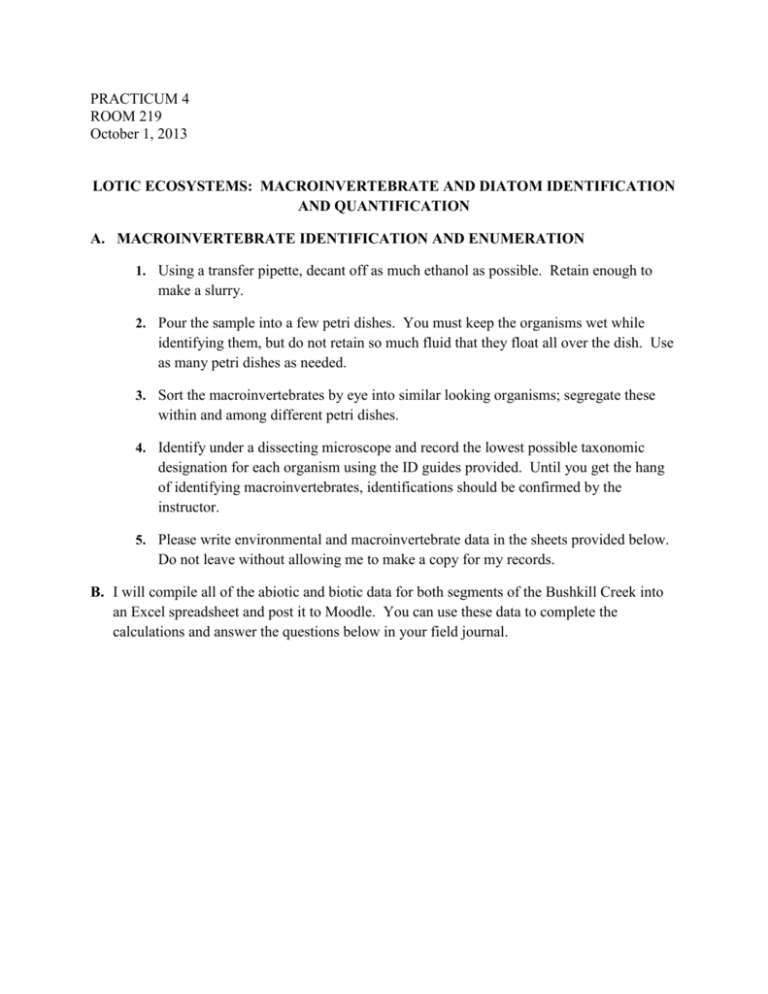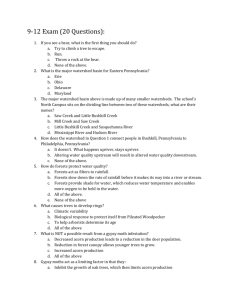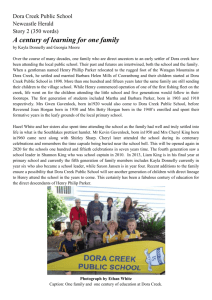Dr. Rothenberger`s Identification Review
advertisement

PRACTICUM 4 ROOM 219 October 1, 2013 LOTIC ECOSYSTEMS: MACROINVERTEBRATE AND DIATOM IDENTIFICATION AND QUANTIFICATION A. MACROINVERTEBRATE IDENTIFICATION AND ENUMERATION 1. Using a transfer pipette, decant off as much ethanol as possible. Retain enough to make a slurry. 2. Pour the sample into a few petri dishes. You must keep the organisms wet while identifying them, but do not retain so much fluid that they float all over the dish. Use as many petri dishes as needed. 3. Sort the macroinvertebrates by eye into similar looking organisms; segregate these within and among different petri dishes. 4. Identify under a dissecting microscope and record the lowest possible taxonomic designation for each organism using the ID guides provided. Until you get the hang of identifying macroinvertebrates, identifications should be confirmed by the instructor. 5. Please write environmental and macroinvertebrate data in the sheets provided below. Do not leave without allowing me to make a copy for my records. B. I will compile all of the abiotic and biotic data for both segments of the Bushkill Creek into an Excel spreadsheet and post it to Moodle. You can use these data to complete the calculations and answer the questions below in your field journal. DATA SHEET Please turn in one completed data sheet per group before leaving lab. Data from all 5 replicates at both sampling stations will be compiled and made available on Moodle. Bushkill Creek under 13th Street Bridge, Easton, PA Sampling site mean current velocity: __________ Depth: __________ Physicochemical characteristics of Bushkill Creek under 13th St. bridge. Temperature (˚C) pH Dissolved oxygen (mg/L) Conductivity (uS/cm) Table 1. Macroinvertebrates identified in Bushkill Creek under 13th St. bridge. Macroinvertebrate Order/Family/Genus Tally Alkalinity (mg/L as CaCO3) DATA SHEET Please turn in one completed data sheet per group before leaving lab. Data from all 3 replicates at both sampling stations will be compiled and made available on Moodle. Bushkill Creek within Henry’s Woods Sampling site mean current velocity: __________ Depth: __________ Physicochemical characteristics of Bushkill Creek within Henry’s Woods. Temperature (˚C) pH Dissolved oxygen (mg/L) Conductivity (uS/cm) Table 2. Macroinvertebrates identified in Bushkill Creek within Henry’s Woods. Macroinvertebrate Order/Family/Genus Tally Alkalinity (mg/L as CaCO3) FIELD JOURNAL Figures, tables, and calculations to include: 1. Copy or cut and paste Tables 1 and 2 (above) into your journal. Questions to consider: 1. What is the total species richness and Simpson biodiversity for Bushkill Creek macroinvertebrates at the 13th Street bridge location? 2. What is the total species richness and Simpson biodiversity for Bushkill Creek macroinvertebrates at the Henry’s Woods location? 3. EPT Taxa Richness is the number of Ephemeroptera (mayfly), Plecoptera (stonefly), and Trichopera (caddisfly) taxa in a sample. Values range from 0 to 12, with low values indicating more organic pollution (from nutrients found in fertilizers, sewage, and other sources). As organic pollution continues to increase, some pollution tolerant macroinvertebrates will become dominant and will be able to support large populations within the stream, while pollution sensitive or semi-sensitive organisms will be unable to survive. EPT are most diverse in natural streams and decline with increasing watershed disturbance. How does the EPT Taxa Richness compare between the 13th Street bridge site and the Henry’s Woods site? 4. Based on your calculations of biodiversity and the EPT values above, do either of these locations along the Bushkill Creek seem to be showing signs of stress? Use the chart below as a guide. Water Quality Excellent Good Fair Poor Very Poor Taxa Richness ≥ 14 12-13 9-11 7-8 ≤6 EPT Taxa Richness ≥5 4 3 2 0-1 5. Next, you will need to calculate the Family Biotic Index (FBI). In the tables below (i.e., use one for the 13th Street bridge site and the other for the Henry’s Woods site), list the names of the macroinvertebrate families collected and the number of individuals in each family in the sample. Look up the tolerance score (Appendix 1) for each family or higher taxon and write it next to the column; multiply the values in the number column by the tolerance score for that row. Sum the resulting numbers, and then divide this sum by the total number of individuals. The equation below is used to calculate the FBI (Hilsenhoff 1988). Table 3. FBI calculation for the Bushkill stream at the 13th St. bridge. Table 4. FBI calculation for the Bushkill stream at Henry’s Woods. 6. If you indicated above that water quality in either or both of these locations is less than good quality, what are some activities within the Bushkill Creek watershed that may be contributing to this decline? APPENDIX 1. Tolerance values for macroionvertebrates (Hilsenhoff 1988)








